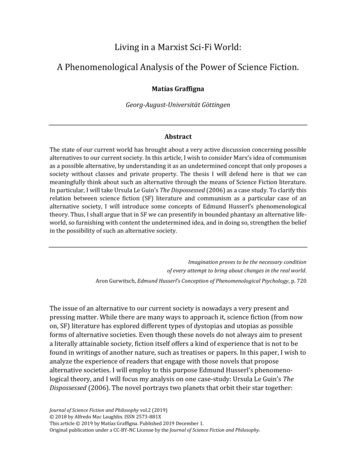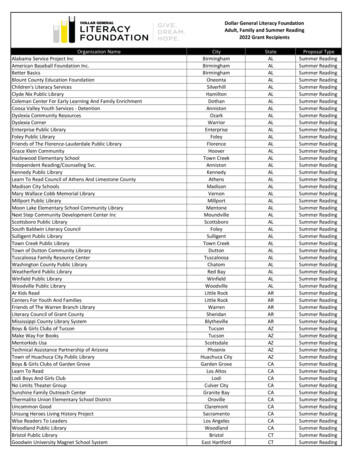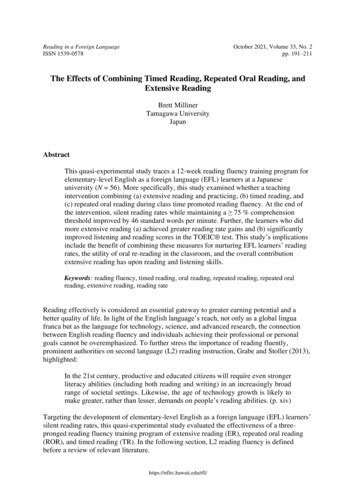
Transcription
An Introduction toMarxistECONOMIC THEORYErnest Mandel
2An Introduction to Marxist Economic TheoryContentsIntroduction by Doug Lorimer . 3I. The Theory of Value and Surplus Value . 5Social surplus product. 5Commodities, use value and exchange value. 7The Marxist theory of alienation. 9The law of value. 10Determination of the exchange value of commodities. 13What is socially necessary labour?. 16The origin and nature of surplus value. 18The validity of the labour theory of value. 20II. Capital and Capitalism . 23Capital in precapitalist society. 23Origins of the capitalist mode of production. 24Origins and definition of the modern proletariat. 27The fundamental mechanism of capitalist economy. 30The growth in the organic composition of capital. 33Competition leads to concentration and monopoly. 36Tendency of the average rate of profit to decline. 37The fundamental contradiction in the capitalist systemand the periodic crises of overproduction. 41III. Neo-Capitalism . 43The origins of neo-capitalism. 43A permanent technological revolution. 45The importance of armament expenditures. 48How crises are ‘amortised’ in a recession. 50The tendency to permanent inflation. 54‘Economic planning’. 55The state guarantee of profit. 58Copyright Resistance Books 2002ISBN: 1876646306Published by: Resistance Books, 23 Abercrombie St, Chippendale NSW 2008, AustraliaPrinted by: El Faro Printing, 79 King St, Newtown NSW 2042, Australia
IntroductionBy Doug LorimerErnest Mandel (1923-95) was the most influential exponent of Marxisteconomic theory in the Western world during the second half of the 20th century,and is best known for his masterful two-volume work Marxist Economic Theory(1962) and his brilliant Late Capitalism (1972).In the former, he demonstrated that it was possible, on the basis of thecontemporary data, to reconstitute the whole economic system of Karl Marx100 years after the first publication of Marx’s Capital. In the latter work, Mandelprovided an explanation of the causes of the 20-year “wave” of rapid growth ofthe world capitalist economy after World War II, which also demonstrated thatit would soon be followed by an indeterminately “long wave” of much slowereconomic growth, and recurrent social and political crises in the developedcapitalist countries.Late Capitalism also provided the first comprehensive analysis of the newfeatures of global capitalism that emerged in the post-war period and that are stillwith us today — transnational corporations as the dominant form of capitalistbusiness organisation, the enormous growth of the services sector, the crucialrole of state expenditure in propping up an economic system marked by financialinstability, long-term stagnation punctuated by speculative booms, mindlessconsumerism and accelerating environmental destruction.This pamphlet, which was first published in French in 1964, provides aconcise exposition of the elementary princples of Marxist economic theory. Inthe first section, Mandel elucidates the basic categories of Marx’s economicdoctrine from the emergence of the social surplus product to the labour theory ofvalue. In the second section, he explains the basic laws of motion of capitalismand its inherent contradictions. In the final second, he applies these to some of thenew features exhibited by the new stage of imperialist capitalism that emergedafter the second world war, which at the time he termed “neo-capitalism”.In his more mature work Late Capitalism, Mandel abandoned this term infavour of the designation “late capitalism”, explaining in the introduction to
4An Introduction to Marxist Economic Theorythat work that the designation “neo-capitalism” could be falsely “interpreted toimply either a radical continuity or discontinuity with traditional capitalism”.Instead, Mandel stressed that the “era of late capitalism is not a new epoch ofcapitalist development [but] merely a further development of the imperialist,monopoly-capitalist epoch” with “the characteristics of the imperialist epochenumerated by Lenin” at the beginning of the 20th century remaining “fullyvalid for late capitalism”.
I. The Theory of Value andSurplus ValueIn the last analysis, every step forward in the history of civilisation has beenbrought about by an increase in the productivity of labour. As long as a givengroup of men barely produced enough to keep itself alive, as long as therewas no surplus over and above this necessary product, it was impossible fora division of labour to take place and for artisans, artists or scholars to maketheir appearance. Under these conditions, the technical prerequisites for suchspecialisation could not possibly be attained.Social surplus productAs long as the productivity of labour remains at a level where one mancan only produce enough for his own subsistence, social division does nottake place and any social differentiation within society is impossible. Underthese conditions, all men are producers and they are all on the same economiclevel.Every increase in the productivity of labour beyond this low point makesa small surplus possible, and once there is a surplus of products, once man’stwo hands can produce more than is needed for his own subsistence, then theconditions have been set for a struggle over how this surplus will be shared.From this point on, the total output of a social group no longer consistssolely of labour necessary for the subsistence of the producers. Some of thislabour output may now be used to release a section of society from having towork for its own subsistence.Whenever this situation arises, a section of society can become a rulingclass, whose outstanding characteristic is its emancipation from the need ofFirst presented at an educational weekend organised by the Paris Federation of theUnited Socialist Party in 1963 and subsequently published in Les Cahiers du Centred’Études Socialistes, February 1964.
6An Introduction to Marxist Economic Theoryworking for its own subsistence.Thereafter, the labour of the producers can be divided into two parts. A part ofthis labour continues to be used for the subsistence of the producers themselvesand we call this part necessary labour; the other part is used to maintain theruling class and we give it the name surplus labour.Let us illustrate this by the very clear example of plantation slavery, as itexisted in certain regions and periods of the Roman Empire, or as we find itin the West Indies and the islands of Portuguese Africa starting with the 17thcentury, on the great plantations which were established there. In these tropicalareas, even the slave’s food was generally not provided by the master; the slavehad to produce this himself by working a tiny plot of ground on Sundays andthe products from this labour constituted his store of food. On six days of theweek the slave worked on the plantation and received in return none of theproducts of his labour. This is the labour which creates a social surplus product,surrendered by the slave as soon as it is produced and belonging solely to theslavemaster.The work week, which in this case is seven days, can be divided into twoparts: the work of one day, Sunday, constitutes necessary labour, that labourwhich provides the products for the subsistence of the slave and his family;the work of the other six days is surplus labour and all of its products go to themaster, are used for his sustenance and his enrichment as well.The great domains of the early Middle Ages furnish us with anotherillustration. The land of these domains was divided into three parts: thecommunal lands consisting of forest, meadows, swamps, etc.; the land workedby the serf for his own and his family’s subsistence; and finally, the land workedby the serf in order to maintain the feudal lord. The work week during thisperiod was usually six days, not seven. It was divided into two equal parts: theserf worked three days on the land from which the yield belonged to him; theother three days he worked on the feudal lord’s land, without remuneration,supplying free labour to the ruling class.The products of each of these two very different types of labour can bedefined in different terms. When the producer is performing necessary labour,he is producing a necessary product. When he is performing surplus labour, heis producing a social surplus product.Thus, social surplus product is that part of social production which isproduced by the labouring class but appropriated by the ruling class, regardlessof the form the social surplus product may assume, whether this be one of naturalproducts, or commodities to be sold, or money.Surplus value is simply the monetary form of the social surplus product.
The Theory of Value and Surplus Value7When the ruling class appropriates the part of society’s production previouslydefined as “surplus product” exclusively in the monetary form, then we use theterm “surplus value” instead of “surplus product”.As we shall see later on, however, the above only constitutes a preliminaryapproach to the definition of surplus value.How does social surplus product come into existence? It arises as aconsequence of a gratuitous appropriation, that is, an appropriation withoutcompensation, by a ruling class of a part of the production of a producingclass. When the slave worked six days a week on a plantation and the totalproduct of his labour was taken by the master without any compensation to theslave, the origin of the social surplus product here is in the gratuitous labour,the uncompensated labour, supplied by the slave to the master. When the serfworked three days a week on the lord’s land, the origin of this income, of thissocial surplus product, is also to be found in the uncompensated labour, thegratuitous labour, furnished by the serf.We will see further on that the origin of capitalist surplus value, that is tosay, the revenue of the bourgeois class in capitalist society, is exactly the same:it is uncompensated labour, gratuitous labour, which the proletarian, the wageworker, gives the capitalist without receiving any value in exchange.Commodities, use value and exchange valueWe have now developed several basic definitions which will be usedthroughout this exposition. A number of others must be added at this point.Every product of human labour normally possesses utility; it must be ableto satisfy a human need. We may therefore say that every product of humanlabour has a use value. The term “use value” will, however, be used in twodifferent senses. We will speak of the use value of a commodity; we will alsotalk about use values, as when we refer, for example, to a society in which onlyuse values are produced, that is to say, where products are created for directconsumption either by the producers themselves or by ruling classes whichappropriate them.Together with this use value, a product of human labour can also have anothervalue, an exchange value. It may be produced for exchange on the marketplace, for the purpose of being sold, rather than for direct consumption by theproducers or by wealthy classes. A mass of products which has been createdfor the purpose of being sold can no longer be considered as the production ofsimple use values; it is now a production of commodities.The commodity, therefore, is a product created to be exchanged on themarket, as opposed to one which has been made for direct consumption. Every
8An Introduction to Marxist Economic Theorycommodity must have both a use value and an exchange value.It must have a use value or else nobody would buy it, since a purchaserwould be concerned with its ultimate consumption, with satisfying some wantof his by this purchase. A commodity without a use value to anyone wouldconsequently be unsaleable, would constitute useless production, would haveno exchange value precisely because it had no use value.On the other hand, every product which has use value does not necessarilyhave exchange value. It has an exchange value only to the extent that the societyitself, in which the commodity is produced, is founded on exchange, is a societywhere exchange is common practice.Are there societies where products do not have exchange value? The basisfor exchange value, and a fortiori for trade and the market place, is constitutedby a given degree of development of the division of labour. In order for productsnot to be directly consumed by their producers, it is essential that everybodyshould not be engaged in turning out the same thing. If a particular communityhas no division of labour, or only its most rudimentary form, then it is clearthat no reason for exchange exists. Normally, a wheat farmer has nothing toexchange with another wheat farmer. But as soon as a division of labour exists,as soon as there is contact between social groups producing different use values,then exchange can come about, at first on an occasional basis, subsequently ona more permanent one. In this way, little by little, products which are made tobe exchanged, commodities, make their appearance alongside those productswhich are simply made for the direct consumption of their producers.In capitalist society, commodity production, the production of exchangevalues, has reached its greatest development. It is the first society in humanhistory where the major part of production consists of commodities. It is nottrue, however, that all production under capitalism is commodity production.Two classes of products still remain simple use value.The first group consists of all things produced by the peasantry for its ownconsumption, everything directly consumed on the farms where it is produced.Such production for self-consumption by the farmer exists even in advancedcapitalist countries like the United States, although it constitutes only a small partof total agricultural production. In general, the more backward the agricultureof a country, the greater is the fraction of agricultural production going forself-consumption. This factor makes it extremely difficult to calculate the exactnational income of such countries.The second group of products in capitalist society which are not commoditiesbut remain simple use value consists of all things produced in the home. Despitethe fact that considerable human labour goes into this type of household
The Theory of Value and Surplus Value9production, it still remains a production of use values and not of commodities.Every time a soup is made or a button sewn on a garment, it constitutesproduction, but it is not production for the market.The appearance of commodity production and its subsequent regularisationand generalisation have radically transformed the way men labour and howthey organise society.The Marxist theory of alienationYou have no doubt already heard about the Marxist theory of alienation.The emergence, regularisation and generalisation of commodity production aredirectly related to the expanding character of this phenomenon of alienation.We cannot dwell on this aspect of the question here but it is extremelyimportant to call attention to it, since the history of trade covers far more thanthe capitalist era. It also includes small-scale commodity production, which wewill discuss later. There is also a postcapitalist society based on commodities,a transitional society between capitalism and socialism, such as present-daySoviet society, for the latter still rests in very large measure on the foundationsof exchange value production. Once we have grasped certain fundamentalcharacteristics of a society based on commodities, we can readily see why itis impossible to surmount certain phenomena of alienation in the transitionalperiod between capitalism and socialism, as in Soviet society, for example.Obviously this phenomenon of alienation does not exist — at least inthe same form — in a society where commodity production is unknown andwhere the life of the individual and his social activity are united in the mostelementary way. Man works, but generally not by himself; most often he is partof a collective group having a more or less organic structure. His labour is adirect transformation of material things. All of this means that labour activity,the act of production, the act of consumption, and the relations between theindividual and his society are ruled by a condition of equilibrium which hasrelative stability and permanence.We should not, of course, embellish the picture of primitive society, whichwas subject to pressures and periodic catastrophes because of its extremepoverty. Its equilibrium was constantly endangered by scarcity, hunger,natural disasters, etc. But in the periods between catastrophes, especially afteragriculture had attained a certain degree of development and when climaticconditions were favourable, this kind of society endowed all human activitieswith a large degree of unity, harmony and stability.Such disastrous consequences of the division of labour as the eliminationof all aesthetic activity, artistic inspiration and creative activity from the act
10An Introduction to Marxist Economic Theoryof production and the substitution of purely mechanical and repetitive taskswere nonexistent in primitive society. On the contrary, most of the arts, music,sculpture, painting, the dance, were originally linked to production, to labour.The desire to give an attractive and appealing form to products which were tobe used either by the individual, his family, or larger kinship groups, found anormal, harmonious and organic expression within the framework of the day’swork.Labour was not looked upon as an obligation imposed from without, first ofall because it was far less intense, far less exhausting than under capitalism today.It conformed more closely to the rhythms of the human organism as well as tothe rhythms of nature. The number of working days per year rarely exceeded150 to 200, whereas under capitalism the figure is dangerously close to 300 andsometimes even greater. Furthermore, there was a unity between the producer,his product and its consumption, since he generally produced for his own use orfor those close to him, so that his work possessed a directly functional aspect.Modern alienation originates basically in the cleavage between the producerand his product, resulting both from the division of labour and commodityproduction. In other words, it is the consequence of working for the market, forunknown consumers, instead of for consumption by the producer himself.The other side of the picture is that a society which only produces usevalues, that is, goods which will be consumed directly by their producers, hasalways in the past been an impoverished society. Not only was it subject to thehazards of nature but it also had to set very narrow limits to man’s wants, sincethese had to conform exactly to its degree of poverty and limited variety ofproducts. Not all human wants are innate to man. There is a constant interactionbetween production and wants, between the development of the productiveforces and the rise of new wants. Only in a society where labour productivitywill be developed to its highest point, where an infinite variety of products willbe available, will it be possible for man to experience a continuous expansionof his wants, a development of his own unlimited potential, an integrateddevelopment of his humanity.The law of valueOne of the consequences of the appearance and progressive generalisationof commodity production is that labour itself begins to take on regular andmeasurable characteristics; in other words, it ceases to be an activity tied to therhythms of nature and according with man’s own physiological rhythms.Up to the 19th century and possibly even into the 20th, the peasants invarious regions of Western Europe did not work in a regulated way, that is to
The Theory of Value and Surplus Value11say, they did not work with the same intensity every month of the year. Therewere periods in the work year when they worked very hard and other periods,particularly during the winter, when all activity virtually came to a halt. It wasin the most backward agricultural areas of most of the capitalist countries thatcapitalist society, in the course of its development, found a most attractivesource of reserve manpower, for here was a labour force available for four tosix months a year at much lower wages, in view of the fact that a part of itssubsistence was provided by its agricultural activity.When we look at the more highly developed and prosperous farms, thosebordering the big cities, for example, and which are basically on the road tobecoming industrialised, we see that work is much more regular and the amountof expended labour much greater, being distributed in a regular way throughoutthe year, with dead seasons progressively eliminated. This holds true not onlyfor our times but even as early as the Middle Ages, at least from the 12th centuryon. The closer we get to the cities, that is to say, to the marketplace, the morethe peasant’s labour becomes labour for the market, that is to say, commodityproduction, and the more regulated and more or less stable his labour becomes,just as if he were working inside an industrial enterprise.Expressed another way, the more generalised commodity productionbecomes, the greater the regulation of labour and the more society becomesorganised on the basis of an accounting system founded on labour.When we examine the already fairly advanced division of labour within acommune at the beginning of commercial and craft development in the MiddleAges, or the collectives in such civilisations as the Byzantine, Arab, Hindu,Chinese and Japanese, certain common factors emerge. We are struck by thefact that a very advanced integration of agriculture and various craft techniquesexists and that regularity of labour is true for the countryside as well as the city,so that an accounting system in terms of labour, in labour-hours, has become theforce governing all the activity and even the very structure of the collectives.In the chapter on the law of value in my Marxist Economic Theory, I give awhole series of examples of this accounting system in work-hours. There areIndian villages where a certain caste holds a monopoly of the blacksmith craftbut continues to work the land at the same time in order to feed itself. The rulewhich has been established is this: when a blacksmith is engaged to make atool or weapon for a farm, the client supplies the raw materials and also worksthe blacksmith’s land during the whole period that the latter is engaged inmaking the implement. Here is a very transparent way of stating that exchangeis governed by an equivalence in work-hours.In the Japanese villages of the Middle Ages, an accounting system in work-
12An Introduction to Marxist Economic Theoryhours, in the literal sense of the term, existed inside the village community. Thevillage accountant kept a kind of great book in which he entered the number ofhours of work done by villagers on each others’ fields, since agriculture was stillmainly based on cooperative labour, with harvesting, farm construction and stockbreeding being done in common. The number of work-hours furnished by themembers of one household to the members of another was very carefully tallied.At the end of the year, the exchanges had to balance, that is, the members ofhousehold B were required to have given household A exactly the same numberof work-hours which members of household A had given household B duringthe year. The Japanese even refined things to the point — almost 1000 yearsago! — where they took into account that children provided a smaller quantity oflabour than adults, so that an hour of child labour was “worth” only a half-hourof adult labour. A whole system of accounting was set up along these lines.There is another example which gives us a direct insight into this accountingsystem based on labour-time: the conversion of feudal rent from one form toanother. In feudal society, the agricultural surplus product could take threedifferent forms: rent in the form of labour (the corvee), rent in kind, and moneyrent.When a change is made from the corvee to rent in kind, obviously a processof conversion takes place. Instead of giving the lord three days of labour perweek, the peasant now gives him a certain quantity of wheat, livestock, etc.,on a seasonal basis. A second conversion takes place in the changeover fromrent in kind to money rent.These two conversions must be based on a fairly rigorous accounting inwork-hours if one of the two parties does not care to suffer a loss in the process.For example, if at the time the first conversion was effected, the peasant gave thelord a quantity of wheat which required only 75 workdays of labour, whereaspreviously he had given the lord 150 workdays of labour in the same year,then this conversion of labour-rent into rent in kind would result in the suddenimpoverishment of the lord and a rapid enrichment of the serfs.The landlords — you can depend on them! — were careful to see to itwhen the conversion was made that the different forms of rent were closelyequivalent. Of course the conversion could eventually turn out to be a bad onefor one of the participating classes, for example, against the landlords, if a sharprise in agricultural prices occurred after rent was converted from rent in kind tomoney rent, but such a result would be historical in character and not directlyattributable to the conversion per se.The origin of this economy based on an accounting in labour-time isalso clearly apparent in the division of labour within the village as it existed
The Theory of Value and Surplus Value13between agriculture and the crafts. For a long time the division remained quiterudimentary. A section of the peasantry continued to produce part of its ownclothing for a protracted historical period, which in Western Europe extendedalmost a thousand years; that is, from the beginning of the medieval citiesright up to the 19th century. The technique of making clothing was certainlyno mystery to the cultivator of the soil.As soon as a regular system of exchange between the farmer and textilecraftsman was established, standard equivalents were likewise established —for example, an ell of cloth [a measure varying from 27 to 48 inches] would beexchanged for 10 pounds of butter, not for 100 pounds. Obviously the peasantsknew, on the basis of their own experience, the approximate labour-time neededto produce a given quantity of cloth. Had there not been a more or less exactequivalence between the time needed to produce the cloth and the time neededto produce the butter for which it was exchanged, there would have been animmediate shift in the division of labour. If cloth production were more lucrativethan butter production, the butter producers would switch to producing cloth.Since society here was only at the threshold of an extreme division of labour,that is to say, it was still at a point where the boundaries between differenttechniques were not clearly marked, the passage from one economic activityto another was still possible, particularly when striking material gains werepossible by means of such a change.In the cities of the Middle Ages as well, a very skilfully calculatedequilibrium existed between the various crafts and was written into the charterswhich specified almost to the minute the amount of labour-time necessary forthe production of different articles. It is inconceivable that under such conditionsa shoemaker or blacksmith might get the same amount of money for a productwhich took half the labour-time which a weaver or other artisan might requirein order to get the same amount of money for his products.Here again we clearly see the mechanism of an accounting system in workhours, a society functioning on the basis of an economy of labour-time, which isgenerally characteristic of the whole phase which we call small-scale commodityproduction. This is the phase intervening between a purely natural economy, inwhich only use values are produced, and capitalist society, in which commodityproduction expands without limit.Determination of the exchange value of commoditiesOnce we have determined that the production and exchange of commoditiesbeco
The work week, which in this case is seven days, can be divided into two parts: the work of one day, Sunday, constitutes necessary labour, that labour which provides the products for the subsistence of the slave and his family; the work of the other six days is surplus labour and all of its products go to the










